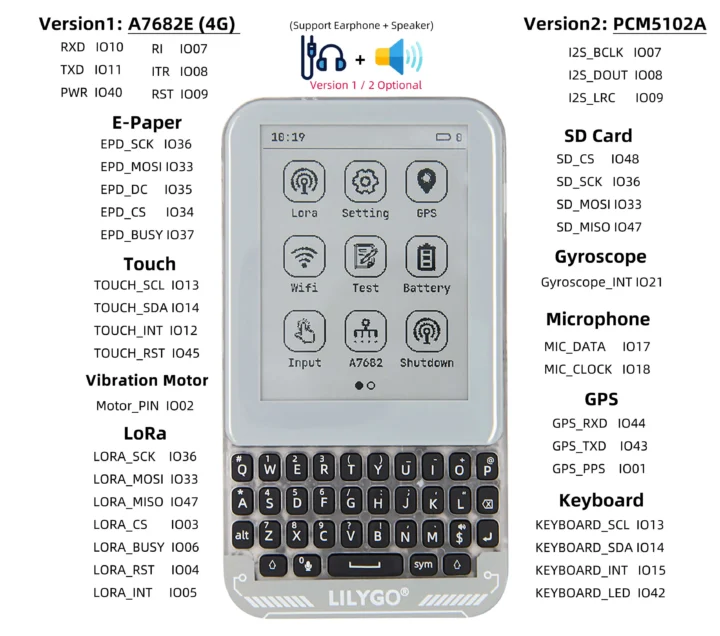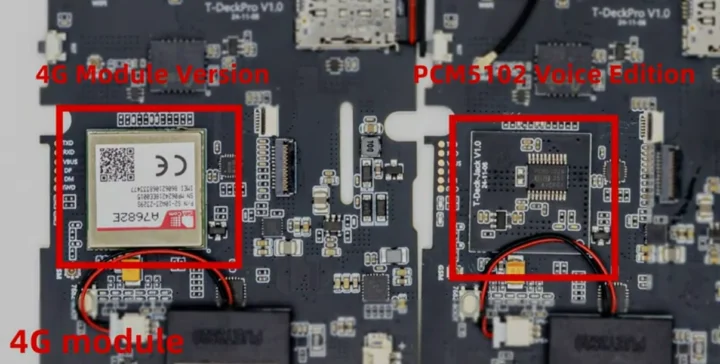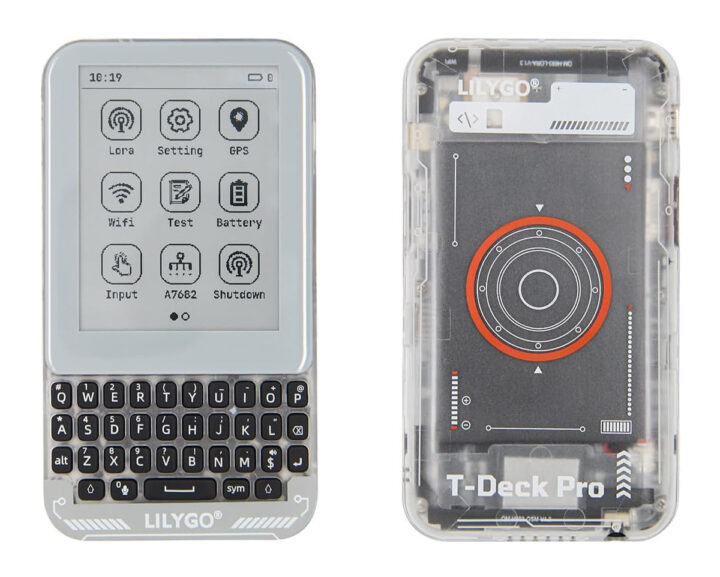LILYGO T-Deck Pro is a LoRa messenger based on an ESP32-S3 WiFi 4 and Bluetooth 5.x SoC, and offered with a 3.1-inch e-paper display with touchscreen, a Blackberry-like QWERTY keyboard, a GPS module, speaker, microphone, and a 3.5mm audio, as well as IMU and light sensors.
It builds upon the T-Deck Plus design, but replacing the 2.8-inch IPS display with a 3.1-inch e-paper display allows for a slimmer design and should offer longer battery life despite the smaller 1,400 mAh battery used in the new model. Two versions of the T-Deck Pro are available: one with a Simcom 4G LTE modem and a cheaper one with a PCM5102A audio codec.
LILYGO T-Deck Pro specifications:
- SoC – ESP32-S3FN16R8
- CPU – Dual-core Tensilica LX7 microcontroller @ up to 240 MHz
- 2.4 GHz 802.11n WiFi 4 and Bluetooth 5.0 LE connectivity
- Memory – 8MB PSRAM
- Storage – 16MB SPI flash
- Storage – MicroSD card slot
- Display – 3.1-inch e-paper display (GDEQ031T10)
- 320×240 resolution
- Touchscreen support via CST328 chip
- Full refresh: 3s; fast refresh: 1s; partial refresh: 0.5s
- Audio
- 3.5mm audio jack
- Microphone, speaker
- Optional PCM5102A audio codec (not in 4G LTE version, as the modem handles audio)
- Wireless
- 2.4 GHz 802.11n WiFi 4 and Bluetooth 5.0 LE connectivity (ESP32-S3)
- SX1262 LoRa module @ 868/915 MHz; up to +22 dBm Tx power (built-in internal antenna and option for external antenna support)
- U-blox MIA-M10Q GPS module
- Optional 4G LTE module (Simcom A7682E) – Not available in version with PCM5102A
- USB – 1x USB Type-C port for power and programming
- User input – QWERTY keyboard using Texas Instruments TCA8418 keypad scan IC
- Sensors – Bosch BHI260AP AI smart sensr with built-in IMU, Lite-on LTR-553ALS light sensor
- Expansion – Qwiic connector
- Misc
- Reset and Boot buttons
- Vibration motor
- Power Supply
- 5V via USB Type-C port
- 1,400 mAh battery; IO04 ADC pin for battery voltage; TP4065B battery charger chip (based on schematics)
- Dimensions – 120 x 66 x 13.5mm

LILYGO says development can be done with the Arduino IDE, PlatformIO, or the ESP-IDF framework. The PDF schematics, datasheets for the main components, firmware files (binaries only), and Arduino code samples with all main features can all be found on GitHub. If it isn’t already, I’d expect Meshtastic off-grid messaging firmware to eventually be ported to the T-Deck Pro.
The main difference between the PCM5102A audio codec and the 4G LTE versions is the way audio is handled. In the 4G LTE version, the A7682E 4G module handles the audio, while in the PCM5102 audio codec version, the ESP32-S3 handles the audio. If I understand that correctly, you can’t process the audio on the ESP32-S3 when using the A7682E, and we’ve previously seen that it could potentially be a nice-to-have feature since LoRa voice/audio communication might be possible on this type of hardware.

The LILYGO T-Deck Pro ESP32-S3 LoRa messenger with e-paper touchscreen display can be purchased on AliExpress for $99.98 (Audio) or $114.98 (4G LTE). Alternatively, the audio model is available on Amazon for $94, but it’s not a way to avoid customs duties since I understand it also ships from China. The device is also listed on the LILYGO store, but it’s out of stock there.

Jean-Luc started CNX Software in 2010 as a part-time endeavor, before quitting his job as a software engineering manager, and starting to write daily news, and reviews full time later in 2011.
Support CNX Software! Donate via cryptocurrencies, become a Patron on Patreon, or purchase goods on Amazon or Aliexpress






